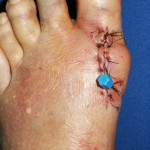Two studies published in the January 7, 2010 issue of the New England Journal of Medicine have received a tremendous amount of play in the popular press. One paper out of Baylor in Houston looked at comparing chlorhexidine + alcohol vs. povidone iodine as a preoperative surgical prep. In a total of 849 subjects in the ITT analysis they found that the surgical site infection rate was significantly lower with the chlorhexidine + alcohol than it was with the old “standby” povidone iodine (9.5% v. 16.1% P=0.004) Here is a link to that abstract http://content.nejm.org/cgi/content/short/362/1/18.
The second study, out of the Netherlands, explored the issue of decolonization in nasal carriers of S. aureus. http://content.nejm.org/cgi/content/short/362/1/9. A total of 6771 patients were screened on admission using PCR for rapid identification of the Staph. 1270 swabs were positive, 808 underwent a surgical procedure. The patients were all treated with mupirocin nasal ointment and chlorhexidine soap vs. a placebo. The rate of S. aureus infection was 3.4% in the treated group vs. 7.7% in the placebo group. Interestingly, ALL were methicillin susceptible (MSSA) so the study may, or may not be able to be extrapolated to MRSA carriage.
Hospital acquired infections, particularly surgical site infections cause a tremendous amount of morbidity and mortality not to mention costing billions of dollars to treat. The monetary situation is complicated by CMS guidelines that may not pay a hospital for treatment of any nosocomial infection. Therefore, new and improved techniques for minimizing these infections are being studied. Some of what is done today for infection prevention in the surgical suite has not changed much in decades i.e. the use of the povidone iodine prep. I remember doing those back when I was a surgical resident in the early 1980s! Chlorhexidine is by no means a new product. In fact, it may be older than povidone iodine. A quick PubMed search finds papers going back to the 1960s. More recently, the combination of chlorhexidine with alcohol has shown to be a better antiseptic with longer activity than chlorhexidine alone. This is true not only for prepping the patient but also as a hand prep for the physician. This recent study just shows us that as new high level evidence becomes available, we may have to change some very ingrained thoughts and practices.
As for the nasal carriage paper, I find that interesting and not unexpected. What needs to be looked at is carriage of MRSA and surgical site infections. There are some papers out there and I do discuss them in the book. This is a more involved topic for another post.



in responce to the following “The rate of S. aureus infection was 3.4% in the treated group vs. 7.7% in the placebo group. Interestingly, ALL were methicillin susceptible (MSSA) so the study may, or may not be able to be extrapolated to MRSA carriage.”
In the treatment of the Pt’s nasal mucosa I am assuming the method of infection transmission to be the aerosolization Staph. It may ,therefore, be prudent to compare the infection rates of treating a Pt’s nares with simply employing the same surgical masks all others in the OR wear. In addition to finding out which method would be superior to controlling infection it could also give insight to the time frame in which a Pt carring Staph. could infect their surgical wound.
Not a comment but a question:
What is the general concensus regarding post operative oral antibiotics in patients receiving implants (screws, etc)? I routinely give a 7 day course of antibiotic coverage in these patients and was trained this way as well. I have been chastized by one of my colleagues for doing this with the opinion being that if the patient developed MRSA post operatively, my antibiotic course could be cited at the cause. I argue that if this were true, then rather than giving Ancef 1g pre-operatively (standard of care), Vancomycin 1g should be given to “prevent” post-operative MRSA. Is there a true standard of care regarding post-operative antibiotics and is there a potentially negative repercussion for doing so?
Thank for your the thoughtful question. Actually, your comment can be broken down in to TWO distinct questions. The first is the duration of antibiotic prophylaxis and the second would be the use of a cephalosporin vs. vancomycin. I think that the consensus is pretty clear that the appropriate duration of antibiotic prophylaxis should be shorter rather than longer. By far the most important dose is the one given BEFORE the surgical procedure. The “first rule” of prophy, as discussed in the Handbook, is that the level should be at its maximum at the time of initial incision. Pretty much all other subsequent doses are “icing on the cake”…up to a point. Most literature points to 24-48 hours of prophylaxis as being acceptable. Any more than that CAN lead to resistance development. A paper by Manian, et al, published in Clinical Infectious Diseases, April 2003 stated that “On multivariate analysis, only discharge to a long term care facility and duration of postoperative antibiotic treatment of >1 day were significantly associated with MRSA Surgical Site Infection”. So, I would have to agree with your colleague on this one…sorry!
As for the second question as to whether or not we should be using anti-MRSA prophy instead of just cefazolin, unfortunately there is little good literature or even consensus that I have seen published. I think that it is an entirely valid suggestion. IF you have a hospital where there is a high incidence of MRSA surgical site infection, then yes, I think it would be reasonable to consider prophy against this organism as opposed to just using a cephalosporin active against MSSA. If most of the surgical infections in your community are still MSSA, then I would hold off on the vancomycin prophylaxis. If anyone reading this is aware of any recent consensus document or clinical trials addressing this issue specifically, I would welcome your input!